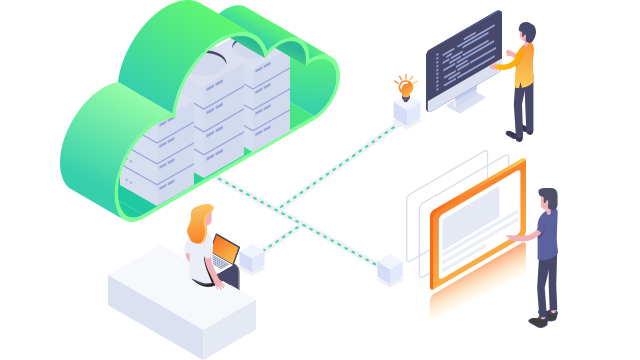AI Cloud Instance
Our cloud service makes it easy to deploy container-based GPU instances in seconds, from either public or private repositories. This means that you can get started with GPU computing quickly and easily, without having to worry about managing your own hardware.

Облачный майнинг
Откройте для себя майнинг в любое время и в любом месте! Мы возьмем на себя все сложности, чтобы вы могли просто наслаждаться вознаграждениями. Начните майнинг в несколько кликов!
Minerplus
Проблемы с центром данных? Мы поможем вам использовать универсальную систему управления.

Ресурсы
Ознакомьтесь с нашим центром ресурсов, чтобы найти необходимую информацию. Подпишитесь и будьте в курсе последних новостей, объявлений и публикаций в блоге.
Подпишитесь на нашу рассылку
Блог о майнинге биткоина и криптовалютах . 16.03.2024
What is a Large Language Model (LLM)? A Beginner's Guide
Information about LLMs, including possible uses and methods for achieving objectives, will be included in this article.

Language models are AI technology's main application, advancing swiftly. AI technology can answer various questions, mimic human expressions, and provide fresh information. LLMs will soon be used in various contexts as they are necessary for improving efficiency. Information about LLMs, including possible uses and methods for achieving objectives, will be included in this article.
What are Large Language Models?
The central component of an LLM is a Transformer, a deep learning architecture. To comprehend the context and meaning of each word, it can process sentences based on the relationships between words. As part of the training process, LLMs gather many words in pairs, rank them, and create correlations between them.
After processing the input data, LLM forecasts the subsequent word in the sentence. It keeps doing this by deciding which option is optimal for each word in the sentence. As a result, the content makes sense and is pertinent, given the selected word. When trying to make sense of something, the LLM uses self-attention to assist them in deciding which words are most crucial. The LLM is informed where each word belongs in the phrase using positional encoding. This facilitates the LLM's understanding of the concept flow and aids the model in comprehending how words function together.
How do Large Language Models Work?
Large language models (LLMs) operate using sophisticated techniques to process and generate language. Central to this operation is the self-attention mechanism, which evaluates the relevance of each word within the input to enhance the model’s understanding of context and semantics. This mechanism is crucial for recognizing relationships over long text sequences, thereby capturing nuances that simpler models might miss. In tandem, the transformer architecture plays a vital role; it comprises an encoder to process the incoming data and a decoder dedicated to constructing the output sequence. This architecture is built from layers of self-attention and feed-forward networks, enabling the model to handle complex linguistic structures efficiently.
Further refining their capabilities, LLMs employ masked language modeling during their training phases. This process involves obscuring parts of the input text and prompting the model to predict the missing words, relying solely on the surrounding context. This method teaches the model to deduce information and fill in linguistic gaps accurately. Additionally, these models make probabilistic predictions, calculating the likelihood of subsequent words based on the accumulated context, thus selecting the most appropriate continuations. The sheer scale of these models, often featuring hundreds of billions of parameters, allows them to learn from vast datasets, capturing a broad spectrum of language patterns. Coupled with transfer learning, where a pre-trained model is fine-tuned with specific data, LLMs achieve a deep understanding and remarkable generative abilities, making them powerful tools for a variety of language-based applications.
How are Large Language Models Trained?
Training an LLM is a resource-intensive process. It involves showing the model lots of text data so it can learn the patterns in the language.
The training process usually includes:
- Data Collection: Gathering a large amount of text from various sources and cleaning it up.
- Tokenization: Breaking the text into smaller units called tokens.
- Model Architecture Selection: Picking a neural network design, often based on transformers like BERT or GPT.
- Pretraining: Training the model on the text data to learn general language patterns.
- Fine-tuning (optional): Adjusting the model for specific tasks or domains.
- Inference: Using the trained LLM for various language tasks.
This process requires a massive powerful GPU cluster and lots of electricity.
Why are large language models important?
How we use technology and approach problems is changing thanks to large language models, or LLMs. They are pretty good at creating and comprehending writing like humans. The ability to customize LLMs is one of its best features. This implies that they can adapt their functionality to meet your needs as a user. It functions similarly to a personal assistant that gets to know your preferences and provides you with the appropriate information.
LLMs excel in sifting through large amounts of material and identifying pertinent information. They can recognize trends and discern people's opinions on various subjects. This facilitates improved decision-making for researchers and enterprises.
Another important factor is language. Real-time translation between languages is possible using LLMs. This facilitates communication and idea-sharing between people in various nations.
LLMs have swift information sorting skills to ensure that everyone can extract clean and clear information quickly. It’s unique because they can assist us with various tasks, including learning, creating, and crisis support. They will continue to advance and transform our daily lives and interactions with technology.
What are the Advantages of Large Language Models?
Large Language Models (LLMs) are more than simply sophisticated technological instruments; they are also adaptable instruments with many benefits that come with specific difficulties that must be overcome. With so much room for advancement and creativity, this discipline has the potential to completely change how we interact with language and information in the future.
Creating responses that look like humans is one of LLMs' most prominent benefits. This talent involves more than just copying human writing; it also consists of comprehending and reproducing the subtleties and intricacies of human language. Because of this, LLMs are very helpful in producing relatable, engaging, and realistic-sounding writing.
Moreover, LLMs exhibit a high degree of contextual understanding ability. They aim to generate content that is appropriate for the context in which it is used and grammatically correct. Because of their ability to modify responses to suit a particular context or subject, LLMs successfully perform various language tasks, including sentiment analysis and summarization.
Another noteworthy benefit of LLMs is their multilingualism. They can function with multiple languages and are not limited to just one, which is very helpful for translation and promoting international communication. This function facilitates more fruitful cross-cultural communication by assisting in removing language barriers.
As LLMs develop, they show adaptability in handling different jobs. To satisfy various objectives, LLMs can be modified for use in sentiment analysis, language translation, content production, and data analysis. Furthermore, their performance improves as they are updated and adjusted with fresh data, increasing their efficiency and accuracy.
What are the Challenges of Large Language Models?
The possibility of prejudice is one of the main worries. Large datasets are used to train LLMs, which may cause them to unintentionally inherit and reinforce the biases found in the training set. This severe problem must be addressed since it may result in biased or unfair outcomes.
- Requirement for practical experience - Because LLMs may need to fully understand the real-world ramifications of the information they process, they may produce prose that seems convincing but needs to be more accurate and coherent. This emphasizes the need for a stronger foundation in common sense and real-world knowledge.
- Resource Intensity - Another area for improvement with LLMs is their resource intensity. These models need a lot of energy and processing capacity to train and implement, which raises concerns about their sustainability and potential environmental effects.
- Transparency - Because AI systems are complicated, it can be challenging for LLMs to comprehend how they arrive at judgments, which raises questions about trust and accountability.
What is the Future of LLMs?
The possibilities for LLMs in terms of upcoming advancements are great. They are working to enhance their architecture and make them more efficient. Multimodal capabilities integration is coming soon, enabling LLMs to deal with text, photos, audio, and video. This has the potential to broaden the scope of uses for LLMs significantly.
Another area of interest for future research is explainability. Establishing confidence and guaranteeing ethical use requires making LLMs' decision-making processes more clear and understandable.
Another area that appears promising for LLMs in the future is domain specialization. We anticipate seeing models with extremely specialized and accurate language generation and understanding capabilities geared toward particular industries. we may expect that access to LLMs will increase as technology develops. More people and organizations will be able to take advantage of LLMs' potential, resulting in creative applications in various sectors.
Even though LLMs have certain drawbacks, their benefits and room for expansion make them an innovative and game-changing technology. We anticipate a day when LLMs will be even more crucial to how we use language and process information as we work to improve these models and solve their problems.
Did you happen to see a cute little Easter egg? A linguistic virtuoso, an LLM in its prime, produced much of the information you've read. How this language behemoth has dissolved distinctions between humans and AI is, perhaps, the biggest shock. Surprisingly, you might have been conversing with something that exists on both the digital and neural levels.
Learn more about AI at Bitdeer
Bitdeer offers a wealth of resources, including tutorials, case studies, and interactive playgrounds, empowering individuals and organizations to explore the exciting world of AI. More suggestions for you:
DISCLAIMER
*Information provided in this article is for general information and reference only and does not constitute nor is intended to be construed as any advertisement, professional advice, offer, solicitation, or recommendation to deal in any product. No guarantee, representation, warranty or undertaking, express or implied, is made as to the fairness, accuracy, timeliness, completeness or correctness of any information, or the future returns, performance or outcome of any product. Bitdeer expressly excludes any and all liability (to the extent permitted by applicable law) in respect of the information provided in this article, and in no event shall Bitdeer be liable to any person for any losses incurred or damages suffered as a result of any reliance on any information in this article.








